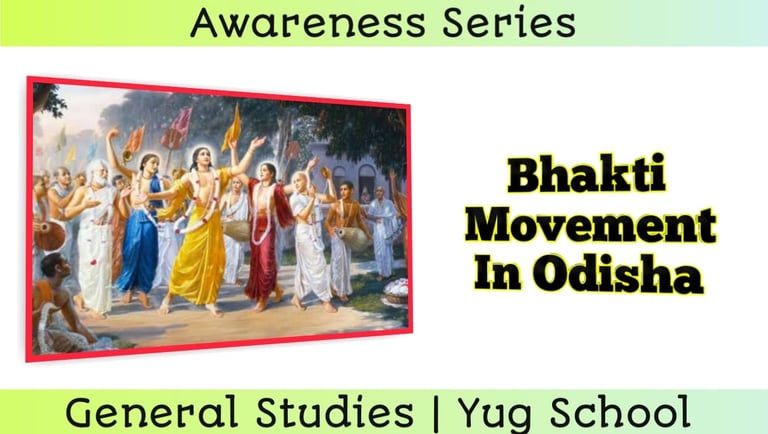Bhakti movement in Odisha and its impact on the society of Odisha
The Bhakti movement's impact continues to be felt in Odia society today. The emphasis on love and devotion, social equality, and cultural expression continues to resonate with people across generations.
GENERAL STUDIES 1


Summary on the Bhakti Movement in Odisha and its Impact on Society
The Bhakti movement in Odisha, also known as Jñanamisrita bhakti or Dadhya Bhakti, played a significant role in shaping the social and cultural landscape of the region. Here's a breakdown of its key aspects and influence:
Early Beginnings and Development:
Emergence: The movement began in the 12th century with figures like Jayadeva, author of the famous devotional poem Gita Govinda.
Growth: By the 14th century, it had become a mass movement, reaching all levels of society.
Key Figures: Prominent Bhakti saints like Balarama Dasa, Achyutananda, Jasobanta Dasa, Ananta Dasa, and Jagannatha Dasa spread the message through public sankirtans (devotional singing). The Panchasakha, a group of five poets, played a crucial role in developing Odia literature and propagating Bhakti ideals.
The influence of Sri Chaitanya Mahaprabhu, who visited Puri in the 16th century, further strengthened the Bhakti movement in Odisha.
Core Tenets:
Direct Relationship with God: Emphasis on a personal and loving relationship with God, accessible to everyone regardless of caste or social status.
Devotion through Bhakti: Achieving salvation through devotion and love, not rituals or strict adherence to scriptures.
Equality and Social Upliftment: Rejection of rigid caste hierarchy and promotion of social equality.
Impact on Odia Society:
Transformation of Religions: The Bhakti movement revitalized Hinduism in Odisha, countering the rise of Islam and other religious influences.
Integration of Culture: Devotional songs, poetry, and dance became popular forms of expression, unifying diverse social groups.
Social Reform: The movement challenged caste discrimination and advocated for social justice, contributing to a more inclusive society.
Flourishing of Literature: Bhakti poetry in Odia language flourished, enriching literary traditions and giving voice to common people's emotions.
Temple Culture: Increased focus on Jagannath temple in Puri, making it a central pilgrimage site and a unifying symbol for Odias.
Political Influence: Contributed to the rise of the Jagannath cult, which became a unifying symbol for the Odia people.
Gender Inclusiveness: While not completely eliminating patriarchal norms, the movement offered some space for women's participation in religious expression through kirtans and devotional activities.
Linguistic Development: The use of Odia language in Bhakti compositions contributed significantly to its development and standardization.
Lasting Legacy:
The Bhakti movement's impact continues to be felt in Odia society today. The emphasis on love and devotion, social equality, and cultural expression continues to resonate with people across generations. The movement's legacy also lies in the rich literary and artistic traditions it fostered, which remain important aspects of Odia's identity.
The Bhakti Movement in Odisha: Impact of Devotion and Social Change
The Bhakti movement, a powerful spiritual and social reformation movement that swept across India during the medieval period, left an indelible mark on the socio-religious fabric of Odisha. Emerging in the southern regions of India around the 6th century CE, the movement emphasized devotion and love for a personal god as the path to salvation, challenging the rigid orthodoxies and hierarchical structures of traditional Hinduism. This wave of devotion reached Odisha, then known as Kalinga, and found fertile ground in its rich cultural and religious heritage.
Early Influences and the Rise of Bhakti in Odisha
While the Bhakti movement originated in South India, its seeds were sown in Odisha with the emergence of prominent figures like Jayadeva in the 12th century. Jayadeva, a court poet of the Ganga dynasty, composed the immortal 'Gita Govinda,' a lyrical masterpiece that celebrated the divine love of Radha and Krishna. This poetic expression of intense devotion and love for God resonated deeply with the masses, laying the foundation for the Bhakti movement in Odisha.
The movement gained momentum in the 14th century with the rise of the Panchasakha, a group of five prominent Odia poets – Balarama Dasa, Jagannatha Dasa, Achyutananda Dasa, Ananta Dasa, and Jasobanta Dasa. These poet-saints, through their simple yet profound teachings and devotional compositions in the Odia language, made the path of devotion accessible to all, regardless of caste, creed, or gender.
The Panchasakha and their Literary Contributions
The Panchasakha played a pivotal role in shaping the Bhakti movement in Odisha. Their literary works, deeply rooted in the philosophy of devotion and love, not only enriched Odia literature but also served as a powerful medium for disseminating their teachings.
Jagannatha Dasa, revered as the 'Adi Kabi' (first poet) of Odia literature, translated the Sanskrit epic 'Mahabharata' into Odia, making it accessible to the common people. His magnum opus, the 'Srimad Bhagavata Mahapurana' in Odia, is a masterpiece of Bhakti literature, extolling the virtues of devotion and surrender to Lord Krishna.
Balarama Dasa, another prominent member of the Panchasakha, composed the 'Dandi Ramayana,' a unique retelling of the epic Ramayana in the Odia language. His work is known for its simplicity and lyrical beauty, making it popular among the masses.
Achyutananda Dasa, a prolific writer and philosopher, authored numerous works on various aspects of Bhakti, philosophy, and yoga. His 'Sunya Samhita' is a significant philosophical treatise that explores the concept of the void and its relation to the divine.
Ananta Dasa, known for his mystical and philosophical compositions, wrote extensively on the nature of God, the soul, and the universe. His works are characterized by their profound insights and spiritual depth.
Jasobanta Dasa, the youngest of the Panchasakha, was a renowned poet and musician. His compositions, filled with devotion and love for God, are still sung in Odia households and temples.
The Panchasakha's literary contributions not only enriched Odia literature but also played a crucial role in democratizing religious knowledge and making it accessible to all sections of society. Their works challenged the dominance of Sanskrit as the language of religious discourse and promoted the use of Odia, the language of the common people, in religious expression.
Sri Chaitanya Mahaprabhu and his Influence
The Bhakti movement in Odisha received further impetus with the visit of Sri Chaitanya Mahaprabhu, a prominent figure in the Gaudiya Vaishnavism tradition, in the 16th century. Chaitanya's teachings, which emphasized the chanting of the holy name of Krishna (sankirtan) as the primary means of attaining spiritual liberation, resonated deeply with the people of Odisha.
Chaitanya's charismatic personality and his fervent devotion to Krishna attracted a large following in Odisha. He spent a significant amount of time in Puri, the abode of Lord Jagannath, and his presence further elevated the importance of Jagannath as a central deity in the Bhakti movement.
Chaitanya's influence on the Bhakti movement in Odisha was profound. He popularized the practice of sankirtan, which became an integral part of Odia religious life. His teachings on prema bhakti (love of God) and the importance of humility and devotion in spiritual practice transformed the religious landscape of Odisha.
Impact on Odia Society
The Bhakti movement had a profound impact on the socio-religious and cultural life of Odisha. It challenged the rigid caste system and promoted social equality, emphasizing that devotion to God was accessible to all, regardless of their social status. This message of inclusivity and equality resonated with the marginalized sections of society, who found solace and hope in the Bhakti movement.
The movement also led to a cultural renaissance in Odisha. The proliferation of devotional literature, music, and art enriched the cultural landscape of the region. The use of Odia language in religious discourse and literary works contributed to the development and standardization of the language.
The Bhakti movement also played a significant role in the development of Odia identity. The emphasis on devotion to Lord Jagannath, the presiding deity of Puri, fostered a sense of unity and shared cultural heritage among the people of Odisha.
Legacy of the Bhakti Movement
The Bhakti movement's legacy continues to shape the socio-religious and cultural life of Odisha. The emphasis on devotion, love, and equality remains deeply ingrained in the Odia psyche. The literary and artistic contributions of the Bhakti saints continue to inspire and influence generations.
The annual Rath Yatra festival in Puri, which celebrates the journey of Lord Jagannath, Balabhadra, and Subhadra to the Gundicha Temple, is a testament to the enduring influence of the Bhakti movement. This grand festival, which attracts millions of devotees from all over the world, symbolizes the spirit of inclusivity and devotion that the Bhakti movement championed.
The Bhakti movement in Odisha was a transformative force that reshaped the religious, social, and cultural landscape of the region. It challenged the rigid orthodoxies of traditional Hinduism, promoted social equality, and fostered a cultural renaissance. The movement's emphasis on devotion, love, and inclusivity continues to resonate with the people of Odisha, making it an integral part of their cultural and spiritual heritage. The legacy of the Bhakti movement serves as a reminder of the power of devotion to transcend social barriers and unite people in the love of God.
